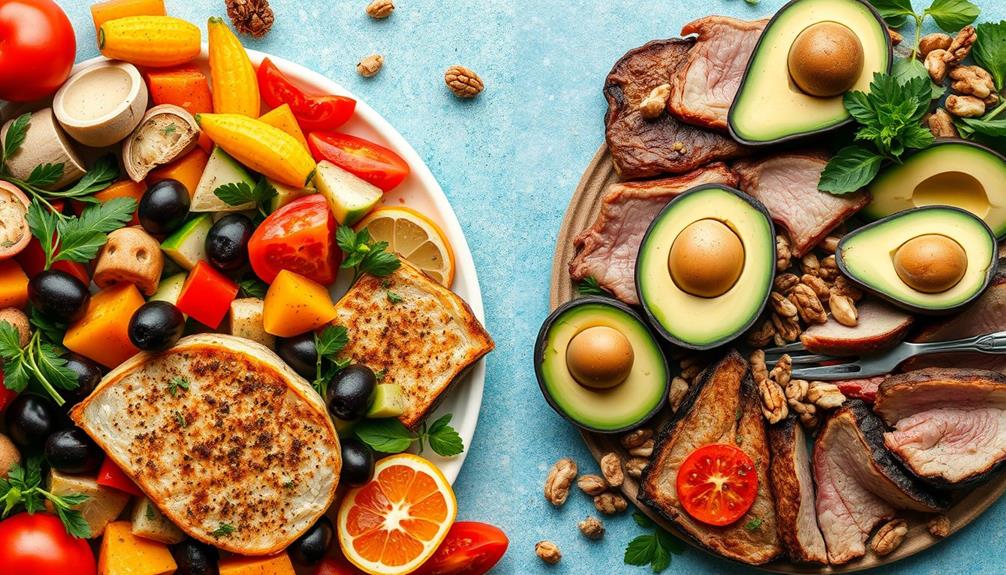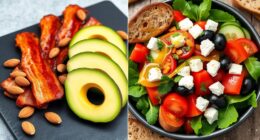A keto breakfast is a meal designed to fuel your body with high fats, moderate protein, and very low carbohydrates, keeping you in ketosis. You'll want to focus on foods like eggs, avocados, full-fat dairy, and low-carb veggies. Forget about traditional choices like bread or cereals. Instead, think creamy smoothies, frittatas, or tasty omelets loaded with cheese and healthy veggies. Aim for a macronutrient ratio of about 75% fats, 20% protein, and just 5% carbs. This isn't just another breakfast; it's a strategic way to start your day right, and there's so much more to uncover! Typical keto breakfast details might also include adding in some healthy fats like coconut oil or MCT oil to your coffee or tea. Some people also enjoy adding in a side of bacon or sausage to their morning meal. Don’t be afraid to get creative with your keto breakfast options and try new recipes to keep things interesting and delicious. Remember, the key is to keep those carbs low and the fats high to keep your body in a state of ketosis.
Key Takeaways
- A keto breakfast focuses on high fat (75%), moderate protein (20%), and very low carbohydrates (5%) to support ketosis.
- Eggs are a versatile staple, providing protein and healthy fats for a satisfying meal.
- Traditional breakfast foods like cereals, bread, and fruits are avoided to keep carbohydrate intake low.
- Low-carb vegetables, full-fat dairy, and creamy avocados are excellent additions for flavor and nutrition.
- Popular keto breakfast alternatives include cream cheese pancakes, frittatas, and high-protein omelets for variety.
Basics of a Keto Breakfast

When you're planning a keto breakfast, what should you focus on? The keto diet emphasizes high fat, moderate protein intake, and low carbohydrate foods. Aim for a macronutrient ratio of about 75% fats, 20% protein, and 5% carbohydrates. This balance supports the ketogenic diet's aims of maintaining ketosis and promoting fat burning.
Start with eggs, which are a staple in many keto breakfasts. You can whip up creamy scrambled eggs or a veggie-packed frittata using low-carb vegetables like spinach or mushrooms. Consider adding healthy fats, such as avocado or full-fat dairy products like cheese or cream, to enhance flavor and meet your calorie intake goals.
Avoid traditional breakfast items like bread, cereals, and fruit, as they typically contain high carbohydrate levels that can disrupt ketosis. Instead, opt for low-carb pancakes made from almond flour or dishes that highlight fatty meats like bacon or sausage.
Ultimately, your keto breakfast should provide sustained energy throughout the day while keeping insulin levels low. By focusing on these principles, you'll set yourself up for successful keto meal planning.
Key Ingredients for Keto Meals

What key ingredients should you include in your keto meals? To kickstart your day with a satisfying keto breakfast, focus on high-fat and low-carb foods. Eggs are a fantastic source of protein and can be prepared in various ways—scrambled, fried, or even as an omelet.
Pair them with creamy avocados, which not only enhance flavor but also provide healthy fats that are essential for maintaining ketosis. Incorporating full-fat dairy, like cheese or Greek yogurt, can boost your nutrient profile while keeping carbs low.
Additionally, consider adding low-carb vegetables such as spinach, bell peppers, and mushrooms to your meals for added vitamins and minerals. For those craving something different, almond flour is an excellent alternative to traditional flour for making pancakes or keto bread. This helps you enjoy familiar textures without compromising your carb limits.
Don't forget to include healthy fats such as olive oil, coconut oil, or nut butters in your breakfast. These fats make up a significant part of your daily macronutrient goals, ensuring you stay energized and satisfied throughout the day.
Common Breakfast Alternatives

For those on a ketogenic diet, swapping out traditional breakfast foods for low-carb alternatives can make a significant difference in maintaining your dietary goals. Instead of toast or pancakes, you can enjoy delicious options like 5-ingredient cream cheese pancakes or 90-second keto bread. These breakfast alternatives keep your carb intake in check while satisfying your cravings.
Consider high-protein, meat-based dishes such as ham, egg, and cheese wraps or veggie-packed frittatas. These meals promote protein consumption and help you feel full longer, aligning perfectly with your low-carb diet.
If you're on the go, a smoothie made with avocado and coconut milk offers a quick, nutritious option that stays within keto guidelines.
You can also use cauliflower as a versatile substitute for starchy ingredients in breakfast dishes. Try cauliflower hash or burrito bowls to create satisfying meals that fit your ketogenic diet.
Nutritional Considerations

A well-planned ketogenic breakfast plays an important role in supporting your dietary goals. When following a ketogenic diet, your macronutrient breakdown should focus on high-fat foods, moderate protein, and very low carbohydrate intake—approximately 75% fats, 20% protein, and just 5% carbohydrates. This helps maintain the state of ketosis, where your body burns fat for fuel instead of glucose.
Keeping your daily carbohydrate intake to 20-50 grams is essential for achieving this. Nutritional options like eggs, bacon, cheese, and low-carb vegetables not only fit this profile but also provide important nutrients while minimizing carbs. A well-formulated keto breakfast can enhance satiety, helping you feel fuller for longer, which supports weight loss by reducing overall calorie intake.
Including fiber-rich low-carb vegetables in your breakfast can aid digestion and help maintain electrolyte balance, especially during the initial adaptation phase of the ketogenic diet.
These considerations are significant to guarantee that your breakfast not only aligns with your keto goals but also promotes overall health and wellness. By focusing on these nutritional elements, you can make the most of your ketogenic breakfast.
Easy Keto Breakfast Recipes

Starting your day with an easy keto breakfast can set the tone for successful meal planning. When you're on a low-carb diet, you'll want meals that are high-fat and filling.
Here are some simple, delicious breakfast recipes you can whip up in no time:
- 5-Ingredient Cream Cheese Pancakes: Blend and enjoy these low-carb pancakes for a satisfying start.
- Breakfast Deviled Eggs: Elevate your eggs with seasoning for a protein-packed option that's easy to make.
- High-Protein Cottage Cheese Omelets: Cook up a creamy omelet loaded with cheese for a quick, nutritious meal.
- Veggie-Packed Frittatas: Customize your frittatas with low-carb veggies instead of starchy ingredients for a hearty meal.
Don't forget about 90-Second Keto Bread. This versatile bread serves as a quick alternative to traditional options and pairs well with avocados or other toppings.
With these easy-to-make recipes, you'll stay nourished and energized while sticking to your keto lifestyle. Enjoy experimenting with flavors and ingredients that keep your breakfast exciting!
Frequently Asked Questions
What Is the Typical Keto Breakfast?
A typical keto breakfast includes high-fat foods like eggs cooked in butter, bacon, and low-carb veggies. You'll want to skip grains and sugars, focusing instead on meals that keep your carb intake low.
What Is the Simplest Way to Understand Keto?
Imagine shedding those extra pounds effortlessly. To understand keto, think of it as flipping your body's fuel switch—burning fat instead of carbs. You cut carbs drastically while embracing healthy fats and proteins, igniting your metabolism.
What Is a Keto Diet Plan for Beginners?
A keto diet plan for beginners focuses on high fats, moderate protein, and very low carbs. You'll want to prioritize whole foods, plan meals carefully, and track your macros to achieve ketosis effectively.
What Is the Basic Rule of a Keto Diet?
Imagine shedding unwanted pounds effortlessly. The basic rule of a keto diet is simple: cut carbs to about 20-50 grams daily. This shift pushes your body into ketosis, burning fat for energy instead of carbs.
Conclusion
In embracing a keto breakfast, you're not just fueling your body; you're transforming your mornings. Imagine savoring a delicious meal that keeps you energized and satisfied, while also promoting weight loss and mental clarity. Many believe that breakfast is the most important meal of the day, but with keto, it's about quality over quantity. By choosing nutritious ingredients, you're setting the tone for a healthier lifestyle, proving that breakfast can be both indulgent and beneficial.









